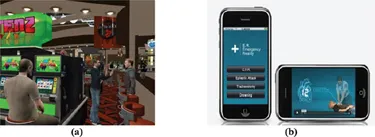
Emerging Technologies for Health and Medicine
Virtual Reality, Augmented Reality, Artificial Intelligence, Internet of Things, Robotics, Industry 4.0
Dac-Nhuong Le, Chung Van Le, Jolanda G. Tromp, Gia Nhu Nguyen, Dac-Nhuong Le, Chung Van Le, Jolanda G. Tromp, Gia Nhu Nguyen
- English
- ePUB (adapté aux mobiles)
- Disponible sur iOS et Android
Emerging Technologies for Health and Medicine
Virtual Reality, Augmented Reality, Artificial Intelligence, Internet of Things, Robotics, Industry 4.0
Dac-Nhuong Le, Chung Van Le, Jolanda G. Tromp, Gia Nhu Nguyen, Dac-Nhuong Le, Chung Van Le, Jolanda G. Tromp, Gia Nhu Nguyen
À propos de ce livre
Showcases the latest trends in new virtual/augmented reality healthcare and medical applications and provides an overview of the economic, psychological, educational and organizational impacts of these new applications and how we work, teach, learn and provide care.
With the current advances in technology innovation, the field of medicine and healthcare is rapidly expanding and, as a result, many different areas of human health diagnostics, treatment and care are emerging. Wireless technology is getting faster and 5G mobile technology allows the Internet of Medical Things (IoMT) to greatly improve patient care and more effectively prevent illness from developing.
This book provides an overview and review of the current and anticipated changes in medicine and healthcare due to new technologies and faster communication between users and devices.
The groundbreaking book presents state-of-the-art chapters on many subjects including:
- A review of the implications of Virtual Reality (VR) and Augmented Reality (AR) healthcare applications
- A review of current augmenting dental care
- An overview of typical human-computer interaction (HCI) that can help inform the development of user interface designs and novel ways to evaluate human behavior to responses in VR and other new technologies
- A review of telemedicine technologies
- Building empathy in young children using augmented reality
- AI technologies for mobile health of stroke monitoring & rehabilitation robotics control
- Mobile doctor brain AI App
- An artificial intelligence mobile cloud computing tool
- Development of a robotic teaching aid for disabled children
- Training system design of lower limb rehabilitation robot based on virtual reality
Foire aux questions
Informations
Part I
VIRTUAL REALITY, AUGMENTED REALITY TECHNOLOGIES AND APPLICATIONS FOR HEALTH AND MEDICINE
CHAPTER 1
REVIEWS OF THE IMPLICATIONS OF VR/AR HEALTH CARE APPLICATIONS IN TERMS OF ORGANIZATIONAL AND SOCIETAL CHANGE
Abstract
1.1 Introduction

